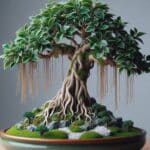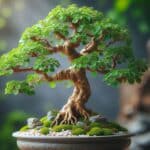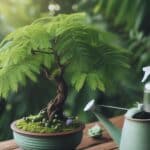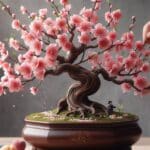Although the name might be a bit confusing, when it comes to growing the bonsai palm tree, very few growers actually grow true palm trees. Instead, they are growing Cycas revoluta, or the sago palm.
Despite the common name, sago palms are actually part of the cycad family. These ancient plants are found growing in the wild in southern Japan and have quite a storied past – they existed back when dinosaurs still roamed the earth!
When you grow your own palm bonsai tree, it probably won’t live 150 million years – however, it will live for decades if cared for properly. Here are tips on how to do that.
Interesting Facts about Sago Palm Tree
| Height | 8-10” |
| Width | 3-5” |
| Sunlight | Full sunlight |
| Flowering Time Length | Does not flower |
| Lifespan | 100+ years |
| Scientific Name | Cycas revoluta |
Growing Bonsai Palm Tree from Seed or by Propagation
The easiest way to grow a sago palm tree is from seed. If you choose to start from seed, it’s best to soak it in water for a few days, then remove the red skin so that all that remains is a hard white seed coat. You can plant your seeds immediately, doing so sideways in well-draining, moist soil. It can take up to nine months for seeds to germinate.
You may find that propagating via offshoots, known as pups, is a faster method of starting your sago palm bonsai tree. These pups should be stripped of their leaves and roots and allowed to dry for one week before planting in a sandy soil mixture.
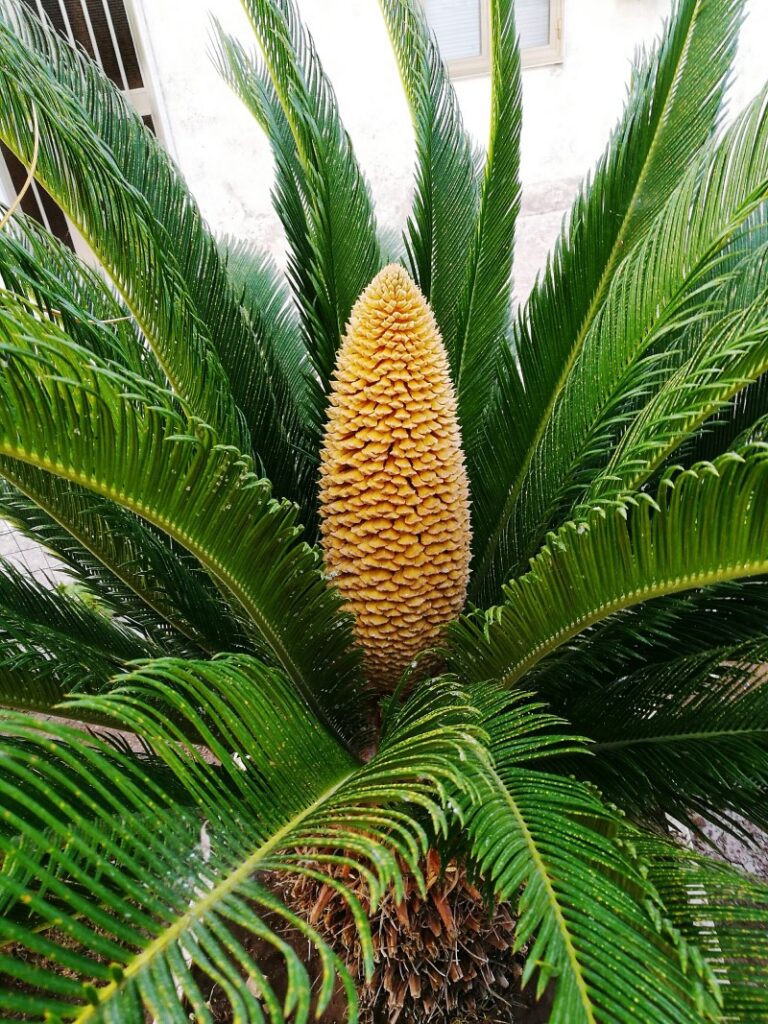
How to Care for Bonsai Palm Tree
Here are some important tips when it comes to sago palm care:
Sunlight
Bonsai palms, like most tropical plants, prefer bright, indirect light. Avoid harsh full sun, which can scorch the leaves. East or west facing windows are ideal.
As for temperature, they thrive in warm environments, ideally between 65-80°F (18-27°C). Avoid placing them near cold drafts or vents. Remember, mimicking their natural habitat is key to keeping your bonsai palm healthy.
Soil
Bonsai palm trees require well-draining soil that allows water to flow freely through the roots while retaining some soil moisture. A blend of coarse sand, peat moss, and perlite or vermiculite creates a balanced and airy growing medium. This soil mixture promotes healthy root development, prevents waterlogging, and allows for adequate aeration.
Additionally, incorporating organic matter, such as compost or pine bark, can provide essential nutrients for optimal growth. Ensure the soil is slightly acidic to neutral, with a pH level around 6.0 to 7.0, to support the health and vitality of bonsai palm trees.
Watering
Just as the bonsai palm tree can handle a wide variety of temperature and lighting conditions, so, too, can it tolerate a variety of watering situations. It can handle a bit of neglect, and in fact, it is best treated just like a cactus or succulent.
It’s perfectly fine to allow the soil to completely dry out between waterings. Just make sure your soil is well-draining and that you do not allow your plant to sit in water for long periods of time.
Fertilizing
The extremely hardy trees require very little when it comes to fertilizing, too. These plants are slow-growing, so just use an organic liquid fertilizer, diluted to half strength, about three or four times per year.
You should fertilize when new growth appears in the spring and late summer, which will harden off new growth and prepare the plant for the more dormant winter months – you should never fertilize during these months, when your plant is not actively growing.
Potting and Repotting
As with fertilizing, less is more when it comes to repotting a bonsai palm tree, too. These plants are slow-growing and prefer being root-bound. Therefore, when you repot, you only need to do so into a container that’s about one size larger than the previous container. Don’t fertilize after you repot.
Pruning Bonsai Palm Tree
Because this tree grows so slowly, minimal pruning is needed. You also do not need to train it with wire. All you need to do is occasionally prune throughout the year, ideally by removing leaves that have turned brown or yellow. Just cut the leaf stalk near the trunk or remove individual sections starting at the midrib area of the leaf.
Pests and Diseases
The most common pest that you will have to deal with when growing a bonsai sago palm tree as a bonsai is scale. These pests can form a hard crust and can be removed with hydrogen peroxide. You may also notice mealy bugs, which can be controlled for with insecticidal soaps. Keep your plant properly watered and turn it regularly to prevent leaf burn and you shouldn’t have any other problems.
One other important note related to the Japanese sago palm tree – make sure you do not put your ancient plant where cats, dogs, or children can reach it. The leaves contain a toxin known as cycasin, which can be dangerous if ingested.
Where to Buy Bonsai Palm Tree
You can purchase a sago palm tree in bonsai form from most specialty bonsai shops. You can also purchase a tree as a small seedling from a tree nursery and grow it in miniature form.
FAQs
How do you keep a Sago Palm small?
To keep a Sago Palm small, limit its pot size and root system space, prune back excessive growth regularly, and provide it with minimal fertilizer. However, it’s important to note that Sago Palms naturally grow slowly, so maintaining a small size may require ongoing pruning and care.
Does Sago Palm need sunlight?
Sago Palms need sunlight to thrive, but they can tolerate a range of light conditions, from full sun to partial shade. Indoors, place them near a bright window where they can receive indirect sunlight for several hours a day.
How do you take care of a Sago Palm indoors?
To care for a Sago Palm indoors, provide it with well-draining soil, adequate sunlight, and regular watering. Allow the top inch of soil to dry out between waterings, and avoid overwatering to prevent root rot. Additionally, fertilize the plant sparingly during the growing season and keep it away from drafts or temperature extremes.
What does an overwatered sago palm look like?
An overwatered Sago Palm may display symptoms such as yellowing or wilting fronds, soft or mushy stems, and root rot. Additionally, the soil may appear waterlogged, and there may be an unpleasant odor emanating from the pot. Adjust watering practices and improve drainage to prevent further damage to the plant.
Final thoughts
In conclusion, with its unique character and air-purifying qualities, the sago palm tree bonsai is a rewarding addition to any home. By following these Sago palm tree bonsai care tips, you can ensure your miniature palm thrives for years to come.
Remember, provide bright, indirect light, maintain consistent moisture, and offer warm temperatures. With proper care and a little patience, your sago palm bonsai will flourish, bringing a touch of the tropics indoors.
For more bonsai trees to grow, check this list of bonsai.
*Image by Ga_Na/depositphotos



